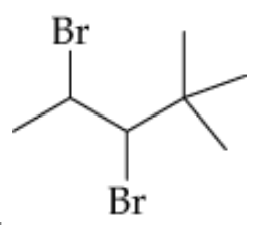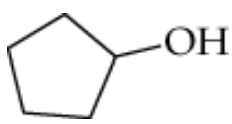 Back
BackProblem 57
Identify the type of reaction for the following:
a.
b.
Problem 60a
What alkene could you use to make the following products? Draw the structure of the alkene, and tell what other reagent is also required for the reaction to occur.
a.
Problem 60c
What alkene could you use to make the following products? Draw the structure of the alkene, and tell what other reagent is also required for the reaction to occur.
c.
Problem 60d
What alkene could you use to make the following products? Draw the structure of the alkene, and tell what other reagent is also required for the reaction to occur.
d.
Problem 61
2,2,3,3-Tetrabromopentane can be prepared by an addition reaction of excess Br2 with an alkyne. Draw the structure of the alkyne and name it.
Problem 62
1-Pentyne reacts with HBr in a 1:1 molar ratio to yield two different addition products, both being bromopentenes and having the chemical formula C5H9Br. Draw the structures of two possible products.
Problem 63
Polyvinylpyrrolidone (PVP) is often used in hair sprays to hold hair in place. Draw a few units of the PVP polymer. The vinylpyrrolidone monomer unit has the following structure:
Problem 65c
For each of the following reagents, decide whether chlorobenzene will react with it or not, and, if it does, draw and name the products expected from the reaction.
c. HNO3 and H2SO4 catalyst
Problem 67
Aromatic compounds do not normally react with hydrogen in the presence of a palladium catalyst but will if very high pressures (200 atm) and high temperatures are used. Under these conditions, toluene adds three molecules of H2 to give an alkane addition product. What is a likely structure for the product?
Problem 68
The explosive trinitrotoluene (TNT) is made by carrying out three successive nitration reactions on toluene. If these nitrations only occur in the ortho and para positions relative to the methyl group, what is the structure of TNT?
Problem 70a,b
The following names are incorrect by IUPAC rules. Draw the structures represented by the following names, and write their correct names. Label each as being symmetrically or unsymmetrically substituted.
a. 2-Methyl-4-hexene
b. 1,3-Dimethyl-1-hexyne
Problem 72
Assume that you have two unlabeled bottles, one with cyclohexane and one with cyclohexene. How could you tell them apart by carrying out chemical reactions?
Problem 76
Cinnamaldehyde, the pleasant-smelling substance found in cinnamon oil, has the following structure:
What products would you expect to obtain from reaction of cinnamaldehyde with water and sulfuric acid catalyst?
Problem 77e
Predict the products of the following reactions:
e.
Problem 79b
Ocimene, a compound isolated from the herb basil, has three double bonds and the IUPAC name 3,7-dimethyl-1, 3-6-octatriene.
b. Draw the structure of the compound formed if enough HBr is added to react with all the double bonds in ocimene.
Problem 81
Which of the following compounds are capable of cis–trans isomerism?
a.
b.
c.
Problem 82
Why do you suppose small-ring cycloalkenes like cyclohexene do not exist as cis–trans isomers, whereas large ring cycloalkenes like cyclodecene do show isomerism?











